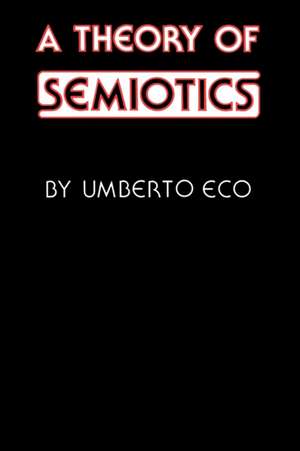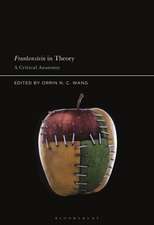A Theory of Semiotics
Autor Umberto Ecoen Limba Engleză Paperback – 31 oct 1978
Librarul mai recomandă
Preț: 232.58 lei
Nou
Puncte Express: 349
Preț estimativ în valută:
44.52€ • 48.37$ • 37.42£
44.52€ • 48.37$ • 37.42£
Carte disponibilă
Livrare economică 29 martie-12 aprilie
Livrare express 15-21 martie pentru 33.89 lei
Preluare comenzi: 021 569.72.76
Specificații
ISBN-13: 9780253202178
ISBN-10: 0253202175
Pagini: 368
Ilustrații: black & white illustrations
Dimensiuni: 152 x 234 x 20 mm
Greutate: 0.54 kg
Editura: MH – Indiana University Press
ISBN-10: 0253202175
Pagini: 368
Ilustrații: black & white illustrations
Dimensiuni: 152 x 234 x 20 mm
Greutate: 0.54 kg
Editura: MH – Indiana University Press
Cuprins
Foreword
Note on graphic conventions
0. Introduction--Toward a Logic of Culture
0.1. Design for a semiotic theory
0.2. ÔSemioticsÕ: field or discipline?
0.3. Communication and/or signification
0.4. Political boundaries: the field
0.5. Natural boundaries: two definitions of semiotics
0.6. Natural boundaries: inference and signification
0.7. Natural boundaries; the lower threshold
0.8. Natural boundaries: the upper threshold
0.9. Epistemological boundaries
1. Signification and Communication
1.1. An elementary communicational model
1.2. Systems and codes
1.3. The s-code as structure
1.4. Information, communication, signification
2. Theory of Codes
2.1. The sign-function
2.2. Expression and content
2.3. Denotation and connotation
2.4. Message and text
2.5 Content and referent
2.6. Meaning as cultural unit
2.7. The interpretant
2.8. The semantic system
2.9. The semantic markers and the sememe
2.10. The KF model
2.11. A revised semantic model
2.12. The model ÒQÓ
2.13. The format of the semantic space
2.14. Overcoding and undercoding
2.15. The interplay of codes and the message as an open form
3. Theory of Sign Production
3.1. A general survey
3.2. Semiotic and factual statements
3.3. Mentioning
3.4 The prolem of a typology of signs
3.5. Critique of iconism
3.6. A typology of modes of production
3.7. The aesthetic text as invention
3.8. The rhetorical labor
3.9. Ideological code switching
4. The Subject of Semiotics
References
Index of authors
Index of subjects
Note on graphic conventions
0. Introduction--Toward a Logic of Culture
0.1. Design for a semiotic theory
0.2. ÔSemioticsÕ: field or discipline?
0.3. Communication and/or signification
0.4. Political boundaries: the field
0.5. Natural boundaries: two definitions of semiotics
0.6. Natural boundaries: inference and signification
0.7. Natural boundaries; the lower threshold
0.8. Natural boundaries: the upper threshold
0.9. Epistemological boundaries
1. Signification and Communication
1.1. An elementary communicational model
1.2. Systems and codes
1.3. The s-code as structure
1.4. Information, communication, signification
2. Theory of Codes
2.1. The sign-function
2.2. Expression and content
2.3. Denotation and connotation
2.4. Message and text
2.5 Content and referent
2.6. Meaning as cultural unit
2.7. The interpretant
2.8. The semantic system
2.9. The semantic markers and the sememe
2.10. The KF model
2.11. A revised semantic model
2.12. The model ÒQÓ
2.13. The format of the semantic space
2.14. Overcoding and undercoding
2.15. The interplay of codes and the message as an open form
3. Theory of Sign Production
3.1. A general survey
3.2. Semiotic and factual statements
3.3. Mentioning
3.4 The prolem of a typology of signs
3.5. Critique of iconism
3.6. A typology of modes of production
3.7. The aesthetic text as invention
3.8. The rhetorical labor
3.9. Ideological code switching
4. The Subject of Semiotics
References
Index of authors
Index of subjects
Textul de pe ultima copertă
'Eco's very erudite and provocative book draws on philosophy, linguistics, sociology, anthropology, and aesthetics and refers to a wide range of scholarship, both European and American. It raises many fascinating questions which merit considerable probing.'-Language in Society
Notă biografică
Umberto Eco















